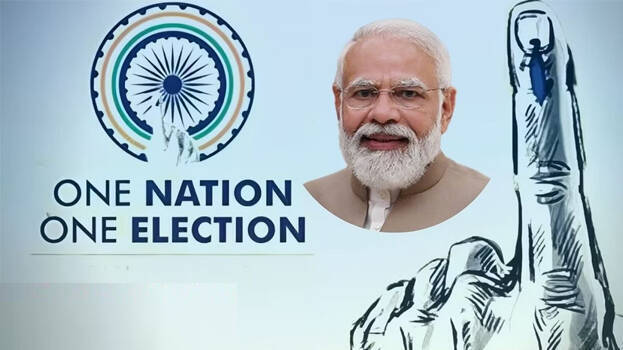Context:
The High-level Committee on Simultaneous Elections headed by the former president of India Shri Ram Nath Kovind submitted its report to the President.
Recommendations of the Committee
- The high-level committee in its comprehensive 18,626-page report unanimously recommended a two-step approach to lead to the simultaneous elections.
- As the first step, simultaneous elections will be held for the Lok Sabha and the State Legislative Assemblies.
- In the second step, Municipalities and Panchayats elections should be held within 100 days of the Lok Sabha and state elections in order to synchronize them with the Lok Sabha and State Legislative Assemblies elections.
- It also recommended there should be a single electoral roll and Electoral Photo Identity Cards (EPIC) for use in elections to all the three tiers of Government.
- The recommendations for simultaneous elections align with the Constitution, requiring minimal amendments.
- Strong backing for simultaneous elections will boost development, enhance social cohesion, and fulfill India’s aspirations.
- The committee concluded that its recommendations will significantly enhance transparency, inclusivity, ease and confidence of the voters.
About “One Nation One Election (ONOE)”
- The ‘One Nation, One Election‘ concept proposes simultaneous elections for all states and the Lok Sabha.
- It requires restructuring of the Indian election cycle to align state and central elections.
- This would involve voters casting their ballots for both the Lok Sabha and state assemblies on the same day, or in a phased manner if necessary.
Other Recommendations
- The 170th Report of the Law Commission (1999) endorsed the concept of simultaneous elections.
- In 2015, the Parliamentary Standing Committee on Personnel, Public Grievances, Law, and Justice 79th Report, suggested the adoption of simultaneous election.
Advantages of ONOE
- Efficient Governance: Model Code of Conduct, triggered twice in a five-year cycle, disrupts
- government operations, leading to governance downtime.
- Cost Reduction: The 2014 general elections reportedly incurred an estimated ₹3,870 crore in expenses.
- Alleviating Strain on Administration: Simultaneous elections would ease the burden on administrative infrastructure and security forces.
- Increased Voter Turnout: The Law Commission suggests that simultaneous elections would enhance voter turnout.
- Timely Policy Implementation: Timely execution of government policies, with the administrative focus shifting towards development activities rather than electioneering.
Criticisms of ONOE
- Against federalism: When an election in a State is postponed until the synchronised phase, President’s rule will have to be imposed in the interim period in that state.
- Impacts voter’s judgement: National and state issues are different, and holding simultaneous election is likely to affect the judgement of voters, probably in favour of national parties.
- Reduces accountability: it will reduce the government’s accountability to the people. Repeated elections keep legislators on their toes[A1] and increase accountability.
- Article 83 and Article 172 of the Constitution deal with the duration of Houses of the Parliament and state legislatures respectively.
Global prospectives
- In Belgium, citizens can participate in five distinct types of elections. Federal Parliament elections typically occur every five years, aligning with European (and thereby regional) elections.
Way forward
- Proposing a Two-Phase Election Process: A Parliamentary Standing Committee recommended the exploration of simultaneous elections in two phases (2.5 years)
- This approach envisions elections taking place every 2.5 years (30 months) across the country once the electoral cycles of the Lok Sabha and all State Assemblies are synchronized, thus preventing premature dissolution.
Also Read:
First Oil Mill under Oil Palm Mission

